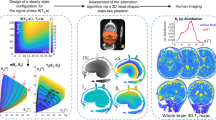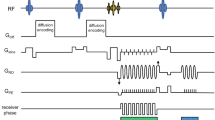Abstract
Object
Dual-echo fast spin-echo (FSE) sequences are used in T 2 relaxometry studies of neurological disorders because of shorter clinical scanning times and protocol simplicity. However, FSE sequences have possible spatial frequency-dependent effects, and derived T 2 values may include errors that depend on the spatial frequency characteristics of the brain region of interest.
Materials and methods
Dual-echo FSE and multi-echo spin-echo (MESE) sequences were acquired in nine subjects. The T 2 decay curves for FSE and MESE sequences were estimated and percent error maps were generated. T 2 error values were obtained along each patient’s corticospinal tract (CST). Whole-brain white matter (WM) and gray matter (GM) T 2 error values were also obtained. The paired t test was performed to evaluate differences in T 2 values in the CST between FSE and MESE sequences.
Results
Histograms of error values in CST and in whole-brain WM and GM structures revealed systematic errors in FSE sequences. Significant differences (P < 0.001) in CST T 2 values were also observed between FSE and MESE sequences.
Conclusion
Our findings indicate that T 2 values derived from FSE sequences are prone to large errors, even in low spatial frequency regions such as the CST, when compared to MESE sequences. Future studies should be aware of this limitation of FSE sequences.




Similar content being viewed by others
Abbreviations
- ALS:
-
Amyotrophic lateral sclerosis
- BET:
-
Brain extraction tool
- CNS:
-
Central nervous system
- CST:
-
Corticospinal tract
- EMG:
-
Electromyography
- FA:
-
Fractional anisotropy
- FAST:
-
FMRIB’s automated segmentation tool
- FLIRT:
-
FMRIB’s linear image registration tool
- FMRIB:
-
Functional magnetic resonance imaging of brain
- FNIRT:
-
FMRIB’s nonlinear image registration tool
- FSE:
-
Dual-echo fast spin echo
- FWHM:
-
Full width at half maximum
- GM:
-
Gray matter
- LMNs:
-
Lower motor neurons
- MESE:
-
Multi-echo spin echo
- MND:
-
Motor neuron disease
- MPRAGE:
-
Magnetization prepared rapid gradient echo
- ROI:
-
Region of interest
- T E :
-
Echo time
- UMNs:
-
Upper motor neurons
- WM:
-
White matter
References
Minnerop M, Specht K, Ruhlmann J, Grothe C, Wullner U, Klockgether T (2009) In vivo voxel-based relaxometry in amyotrophic lateral sclerosis. J Neurol 256(1):28–34
Okujava M, Schulz R, Ebner A, Woermann FG (2002) Measurement of temporal lobe T2 relaxation times using a routine diagnostic MR imaging protocol in epilepsy. Epilepsy Res 48(1–2):131–142
Coan AC, Bonilha L, Morgan PS, Cendes F, Li LM (2006) T2-weighted and T2 relaxometry images in patients with medial temporal lobe epilepsy. J Neuroimaging 16(3):260–265
Vymazal J, Klempir J, Jech R et al (2007) MR relaxometry in Huntington’s disease: correlation between imaging, genetic and clinical parameters. J Neurol Sci 263(1–2):20–25
Neema M, Goldberg-Zimring D, Guss ZD et al (2009) 3 T MRI relaxometry detects T2 prolongation in the cerebral normal-appearing white matter in multiple sclerosis. Neuroimage 46(3):633–641
Mitsumoto H, Chad DA, Pioro EP (1998) Amyotrophic lateral sclerosis. F.A. Davis Company, Philadelphia
Yagishita A, Nakano I, Oda M, Hirano A (1994) Location of the corticospinal tract in the internal capsule at MR imaging. Radiology 191(2):455–460
Poon CS, Henkelman RM (1992) Practical T2 quantitation for clinical applications. J Magn Reson Imaging 2(5):541–553
Whittall KP, MacKay AL, Li DK (1999) Are mono-exponential fits to a few echoes sufficient to determine T2 relaxation for in vivo human brain? Magn Reson Med 41(6):1255–1257
Duncan JS, Bartlett P, Barker GJ (1996) Technique for measuring hippocampal T2 relaxation time. Am J Neuroradiol 17(10):1805–1810
Jack CR Jr (1996) Hippocampal T2 relaxometry in epilepsy: past, present, and future. Am J Neuroradiol 17(10):1811–1814
Hashemi RH, Bradley WG, Lisanti CJ (2004) MRI: the basics, 2nd edn. Lippincott Williams &Wilkins, Philadelphia
Brant-Zawadzki M, Gillan GD, Nitz WR (1992) MPRAGE: a three-dimensional, T1-weighted, gradient-echo sequence—initial experience in the brain. Radiology 182(3):769–775
Carneiro AAO, Vilela GR, de Araujo DB, Baffa O (2006) MRI relaxometry: methods and applications. Braz J Phys 36:9–15
Smith SM, Jenkinson M, Woolrich MW et al (2004) Advances in functional and structural MR image analysis and implementation as FSL. Neuroimage 23(Suppl 1):S208–S219
Jenkinson M (2003) Fast, automated, N-dimensional phase-unwrapping algorithm. Magn Reson Med 49(1):193–197
Jiang H, van Zijl PC, Kim J, Pearlson GD, Mori S (2006) DtiStudio: resource program for diffusion tensor computation and fiber bundle tracking. Comput Meth Prog Bio 81(2):106–116
Mori S, Crain BJ, Chacko VP, van Zijl PC (1999) Three-dimensional tracking of axonal projections in the brain by magnetic resonance imaging. Ann Neurol 45(2):265–269
Wakana S, Caprihan A, Panzenboeck MM et al (2007) Reproducibility of quantitative tractography methods applied to cerebral white matter. Neuroimage 36(3):630–644
Jenkinson M, Smith SM (2001) A global optimisation method for robust affine registration of brain images. Med Image Anal 5(2):143–156
Smith SM (2002) Fast robust automated brain extraction. Hum Brain Mapp 17(3):143–155
Zhang Y, Brady M, Smith SM (2001) Segmentation of brain MR images through a hidden Markov random field model and the expectation-maximization algorithm. IEEE Trans Med Imaging 20(1):45–57
Jenkinson M, Bannister PR, Brady JM, Smith SM (2002) Improved optimisation for the robust and accurate linear registration and motion correction of brain images. NeuroImage 17(2):825–841
Brix G, Kolem H, Nitz WR (2008) Image contrast and Imaging sequence. In: Reiser RF (ed) Magnetic resonance tomography. Springer, Berlin, pp 36–75
Pai A, Li X, Majumdar S (2008) A comparative study at 3 Tesla of sequence dependence of T2 quantitation in the knee. Magn Reson Imaging 26(9):1215–1220
Hawnaur JM, Hutchinson CE, Isherwood I (1994) Clinical evaluation of fast spin echo sequences for cranial magnetic resonance imaging at 0.5 Tesla. Br J Radiol 67(797):423–428
Constable RT, Anderson AW, Zhong J, Gore JC (1992) Factors influencing contrast in fast spin-echo MR imaging. Magn Reson Imaging 10(4):497–511
Acknowledgments
The authors thank all the patients who participated in this study.
Author information
Authors and Affiliations
Corresponding author
Electronic supplementary material
Below is the link to the electronic supplementary material.
Rights and permissions
About this article
Cite this article
Rajagopalan, V., Lowe, M.J., Beall, E.B. et al. T 2 relaxometry measurements in low spatial frequency brain regions differ between fast spin-echo and multiple-echo spin-echo sequences. Magn Reson Mater Phy 26, 443–450 (2013). https://doi.org/10.1007/s10334-012-0364-1
Received:
Revised:
Accepted:
Published:
Issue Date:
DOI: https://doi.org/10.1007/s10334-012-0364-1




